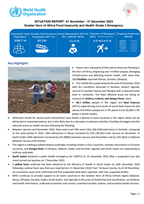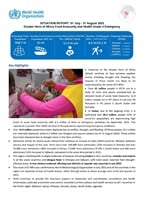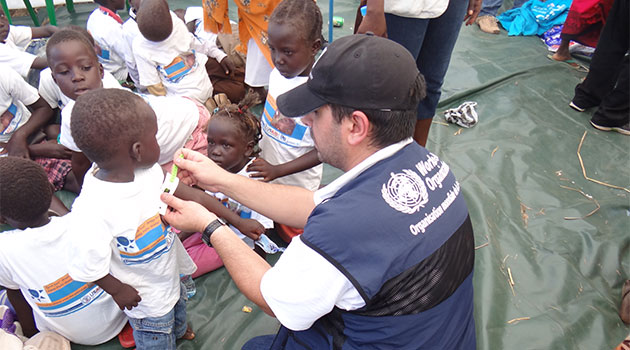.tmb-1920v.jpg?sfvrsn=5081daaa_3)

Drought and food insecurity in the greater Horn of Africa

Donate
© WHO / Billy Miaron
Overview
Millions in the greater Horn of Africa are facing acute
hunger as the region faces one of the worst droughts in recent decades,
compounded by years of conflict and instability, the impact of the COVID-19
pandemic and rising food prices due to, in part, the war in Ukraine.
As families face severe food insecurity, many have left
their homes in search of food and water, and pasture for animals. Large-scale displacement is often accompanied by
a deterioration in hygiene and sanitation. Outbreaks of infectious diseases are
a major concern, especially when combined with low existing vaccination
coverage and health service availability.
As people become increasingly food insecure, they also must
make the impossible choice between food and healthcare, even as nutritional
deficiencies make them increasingly vulnerable to disease. This is particularly
true for children, for whom the combination of malnutrition and disease can
prove fatal.
With malnutrition and displacement, the need for health
services will increase as people become weaker and more vulnerable to disease.
WHO is coordinating with partners in the health sector and
beyond to ramp up its response in the region to avert the worst effects of food insecurity and to give people access to the health services they need.
Along with countering the consequences of malnutrition, WHO
is helping countries to prepare for outbreaks of diseases like cholera, measles
and malaria. This includes improving surveillance systems for communicable
diseases to identify and respond to new outbreaks quickly.
Among affected populations, WHO helps ensure that essential health services like those for sexual and reproductive health, treatment for chronic infectious diseases such as tuberculosis and HIV, as well as mental health services as people are at high risk of violence and distress can continue without disruption.
Publications
All →
Snapshot: Greater Horn of Africa food insecurity and health - grade 3 emergency: 31 January 2024
The Greater Horn of Africa is one of the most vulnerable regions to climate change. The historic four-year drought that hit East Africa caused massive...

Situation Report: Greater Horn of Africa Food Insecurity and Health - Grade 3 Emergency — 01 November...
Heavy rains induced by El Nino led to extensive flooding in the Horn of Africa, displacing over 4 million people, damaging infrastructure and affecting...

Situation Report: Greater Horn of Africa Food Insecurity and Health - Grade 3 Emergency — 1 September...
Countries in the Horn are experiencing increased rainfall resulting in flooding and river overflows influenced by El-Niño and a positive Indian...

Snapshot: Greater Horn of Africa food insecurity and health - grade 3 emergency: 7 November 2023
The prolonged drought and flooding severely impacted people’s health and deepened a health crisis in the Greater Horn of Africa. The elevated levels...

Situation Report: Greater Horn of Africa Food Insecurity and Health - Grade 3 Emergency — 1 July 2023...
Countries in the Greater Horn of Africa (GHoA) continue to face extreme weather events including drought and flooding; the impacts of these events are...

Snapshot: Greater Horn of Africa food insecurity and health - grade 3 emergency: 31 August 2023
The prolonged drought and flooding severely impacted people’s health and deepened a health crisis in the Greater Horn of Africa. The elevated levels...

Situation Report: Greater Horn of Africa Food Insecurity and Health - Grade 3 Emergency — 1 April 2023...
Countries in the greater Horn of Africa continued to face extreme weather events including drought and flooding. Flooding from March – May 2023...

Snapshot: Greater Horn of Africa food insecurity and health - grade 3 emergency: 12 July 2023
The greater Horn of Africa is facing a dire food insecurity crisis resulting from extreme weather events, along with conflict, the fallout from the COVID-19...

Situation report: Greater Horn of Africa food insecurity and health - grade 3 emergency: 1 February —...
Countries in the greater Horn of Africa continued to face extreme weather events including drought due to five failed rainy seasons and flooding...

Situation Report: Greater Horn of Africa Food Insecurity and Health - Grade 3 Emergency — 1 January 2023...
The Greater Horn of Africa (GHoA) countries have continued to face serious drought situation due to five failed rainy seasons. Rainfall is projected...









